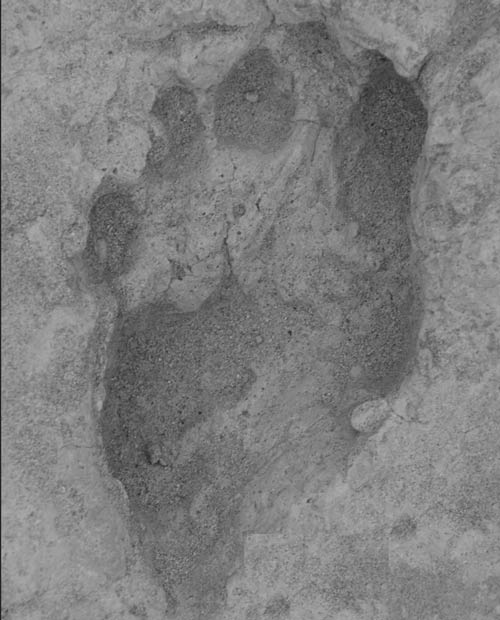The Shoe Fits! 1.5 Million-Year-Old Human Footprints Found

Early humans had feet like ours and left lasting impressions in the form of 1.5 million-year-old footprints, some of which were made by feet that could wear a size 9 men's shoe.
The findings at a Northern Kenya site represent the oldest evidence of modern-human foot anatomy. They also help tell an ancestral story of humans who had fully transitioned from tree-dwellers to land walkers.
"In a sense, it's like putting flesh on the bones," said John Harris, an anthropologist with the Koobi Fora Field School of Rutgers University. "The prints are so well preserved ."
Almost human
Harris and other colleagues report in the Feb. 27 issue of the journal Science on finding several footprint trails within two sedimentary rock layers. An upper sedimentary layer included two trails of two prints each, one group of seven prints, and a variety of isolated prints. The lower layer had a trail of two prints and a single isolated print likely from a smaller, juvenile human.
The researchers identified the footprints as probably belonging to a member of Homo ergaster, an early form of Homo erectus. Such prints include modern foot features such as a rounded heel, a human-like arch and a big toe that sits parallel to other toes.
By contrast, apes have more curved fingers and toes made for grasping tree branches. The earliest human ancestors, such as Australopithecus afarensis, still possessed many ape-like features more than 2 million years ago — the well-known "Lucy" specimen represents one such example.
Get the world’s most fascinating discoveries delivered straight to your inbox.
Make me a match
These latest footprints at Ileret, Kenya, appear intriguingly close by to another early human site. Researchers in 1984 found a nearly complete Homo erectus skeleton, dubbed the "Turkana Boy" specimen, just across the waters of Lake Turkana.
Turkana Boy's delicate foot bones were not well preserved. But the new footprints could represent the shoe that fits the wearer, so to speak.
"Many people have predicted this, but now we have the solid evidence for modern foot anatomy," Harris told LiveScience. "It's like a giant jigsaw puzzle, and those footprints complement the skeleton from the other end of the lake."
Time may change me
Modern feet mark just one of several dramatic shifts in early humans, specifically regarding the appearance of Homo erectus around 2 million years ago. Homo erectus is the first hominid to have the same body proportions as modern Homo sapiens.
"We're seeing a very different hominid at this stage," Harris said, pointing to both an increase in size and change in stride during the relatively short time between Australopithecus (the first in this genus lived about 4 million years ago and the last died out between 3 million and 2 million years ago) and Homo erectus. The latter hominids would have been able to travel more quickly and efficiently over larger areas.
This matches a pattern of more widely-distributed sites containing artifacts such as tools from 1.5 million to 1 million years ago, which may also point to wider-ranging early humans.
Climate changing and shifting physical landscapes would have also forced the likes of Homo erectus to wander farther in search of food, Harris said. But increased walking and running abilities may have allowed them to start seriously hunting big game
"You might even think in terms of dietary quality here, because maybe they're incorporating more meat into their diet," Harris said. "They would have competed with quite a large carnivore guild; lions, leopards, and all the cats that eat meat."
The tracks lead on
The Homo erectus footprints now lead further into the past of human evolution, as researchers may shift their focus to earlier examples of physical changes in human ancestor species.
"It's going to bring up controversy again about the Laetoli prints," Harris noted, referring to footprints preserved in volcanic ash roughly 3.6 million years ago in Tanzania. Anthropologists continue to debate whether these older footprints from an earlier "Lucy" type hominid show that Australopithecus walked about easily or awkwardly on two legs.
Other findings may yet be revealed with the latest footprints at the Ileret site. The prehistoric landscape near various water sources was likely a muddy surface that preserved a whole range of animal tracks, Harris hinted — perhaps fodder for additional studies in the future.
- Video - 1.5 Million-Year-Old Footprints Found
- Top 10 Missing Links in Human Evolution
- Why We Walk Upright: Beats Being a Chimp



